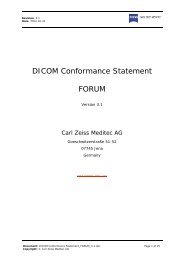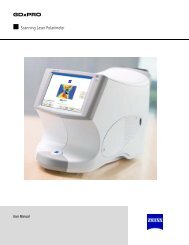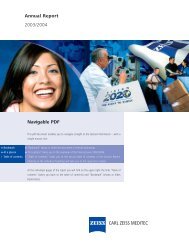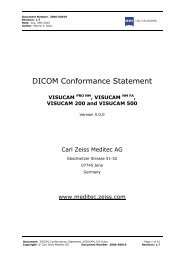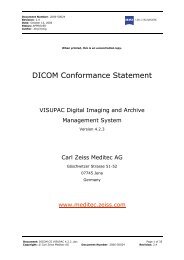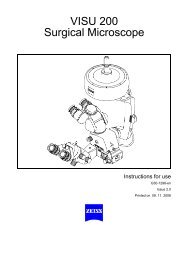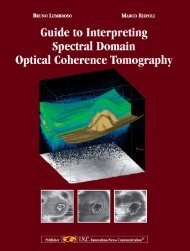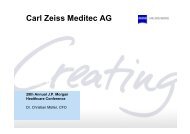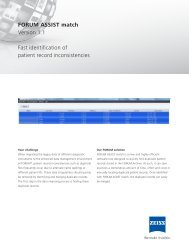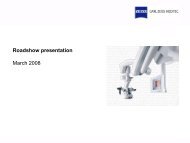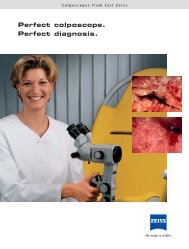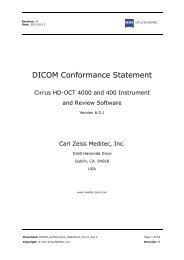Download - Carl Zeiss Meditec AG
Download - Carl Zeiss Meditec AG
Download - Carl Zeiss Meditec AG
Create successful ePaper yourself
Turn your PDF publications into a flip-book with our unique Google optimized e-Paper software.
ReLEx smile: Flapless. All-femto. Single-step.<br />
Efficacy and Safety With<br />
ReLEx smile<br />
An overview of the clinical advantages of this procedure.<br />
BY JODHBIR S. MEHTA, MD<br />
ReLEx smile may just be the paradigm shift in laser vision<br />
correction that refractive surgeons have been waiting<br />
for. Instead of weakening the biomechanical stability<br />
with ablation procedures such as LASIK, surgeons<br />
now have the ability to perform refractive correction by<br />
creating a lenticule inside the intact cornea and subsequently<br />
removing it through a small (less than 4 mm)<br />
incision. This technique does not completely sever nerve<br />
pathways and avoids the need to create a flap, which<br />
provides surgeons with the opportunity to perform<br />
minimally invasive refractive corneal surgery.<br />
This article overviews the clinical advantages of lenticule<br />
extraction compared with the most commonly<br />
performed refractive surgery technique in the world:<br />
LASIK. If the excellent results with ReLEx smile continue,<br />
we believe that it has the potential to overtake LASIK in<br />
terms of popularity. Because ReLEx smile is flapless and<br />
requires an 80% smaller sidecut incision in the anterior<br />
cornea and a 30% smaller lamellar incision (cap cut)<br />
than the LASIK flap, biomechanical stability is minimally<br />
reduced and dry eye syndrome avoided.<br />
EARLY STUDIES<br />
In our first preclinical study, 1 my colleagues and I performed<br />
a paired eye study in 36 rabbits to compare ReLEx<br />
flex with standard LASIK. Although ReLEx flex requires flap<br />
creation, it is typically just 0.5 to 1.0 mm larger in diameter<br />
than the optical zone. In the first study, 18 rabbit eyes<br />
underwent ReLEx flex and 18 underwent LASIK. In each<br />
group, we looked at three refractive correction subgroups,<br />
-3.00, -6.00, and -9.00 D, to determine the differences of<br />
the two procedures in early wound-healing responses.<br />
This study showed that, compared with LASIK, ReLEx had<br />
a better postoperative wound-healing response, resulting<br />
in less topographic changes, less inflammation, and less<br />
extracelluar matrix deposition. These findings were statistically<br />
significant at high refractive corrections (-6.00 D and<br />
above). There was, however, no difference between the<br />
groups in cell death and proliferation after surgery.<br />
Our take-home message from this study was that,<br />
with ReLEx, approximately the same amount of energy<br />
8 SUPPLEMENT TO CATARACT & REFRACTIVE SURGERY TODAY EUROPE OCTOBER 2012<br />
is applied to the eye regardless of the level of correction.<br />
The energy is equivalent to approximately 0.58 J. With<br />
LASIK, however, the energy required to complete the<br />
ablation increases as the level of correction increases.<br />
Therefore, the energy can range from 4 J for a low correction<br />
to 12 J, for instance, for a -9.00 D correction.<br />
After we determined that ReLEx resulted in good postoperative<br />
wound healing in rabbit eyes, we began to wonder<br />
if the laser cuts required for the procedure would affect the<br />
stromal bed quality with different ablations. Did these cuts<br />
in the cornea make the stromal bed rougher than preoperatively,<br />
and would that result in slower visual recovery?<br />
Would the stromal bed be roughest in higher myopic eyes<br />
because deeper cuts were required? To answer these questions,<br />
we performed a prospective clinical case series in 33<br />
patients who underwent ReLEx flex in both eyes 2 and a<br />
human eye-bank study on donor cadaver eyes to look at<br />
stromal bed smoothness on scanning electron microscopy.<br />
During this human eye-bank study, we were able to<br />
show that the degree of roughness of the stromal bed<br />
was independent of the level of myopic correction. The<br />
laboratory results were supported by the clinical visual acuity<br />
results. The mean preoperative spherical equivalent (SE)<br />
was -5.77 ±2.04 D, improving to 0.14 ±0.53 D at 3 months<br />
postoperatively. Additionally, UCVA in 94% of eyes was<br />
20/25 or better at 3 months, and all eyes achieved refractive<br />
stability within 1 month after surgery (P



